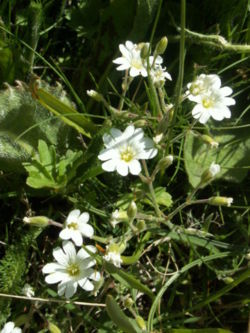Cerastium arvense: Difference between revisions
No edit summary |
No edit summary |
||
| Line 1: | Line 1: | ||
{{Inc| | |||
Cerastium arvense, Linn. (var. oblongifolium, Holl. & Brit.). Starry Grasswort. Fig. 876. Perennial, low, much branched and matted: sts. 8-12 in. long: lvs. oblong or lanceolate, pale green, pubescent, obtuse,½-1½ in. long, ¼in. wide: fls. very numerous, appearing in Apr. and May; petals 5, deeply bifid: caps, twice as long as the calyx.—A species of very wide range, growing mostly in dry rocky places from Labrador to Alaska and south to Ga. and Calif.; also in Asia and Eu. Gn. 71, p. 504.—Recommended as a bedding plant, for its mat-like habit, covered with white bloom. Var. compactum, Hort., is hardy in S. E. Canada. | |||
}} | |||
{{Taxobox | {{Taxobox | ||
| color = lightgreen | | color = lightgreen | ||
Revision as of 09:45, 28 June 2009
| Standard Cyclopedia of Horticulture |
|---|
|
Cerastium arvense, Linn. (var. oblongifolium, Holl. & Brit.). Starry Grasswort. Fig. 876. Perennial, low, much branched and matted: sts. 8-12 in. long: lvs. oblong or lanceolate, pale green, pubescent, obtuse,½-1½ in. long, ¼in. wide: fls. very numerous, appearing in Apr. and May; petals 5, deeply bifid: caps, twice as long as the calyx.—A species of very wide range, growing mostly in dry rocky places from Labrador to Alaska and south to Ga. and Calif.; also in Asia and Eu. Gn. 71, p. 504.—Recommended as a bedding plant, for its mat-like habit, covered with white bloom. Var. compactum, Hort., is hardy in S. E. Canada.
|
| Cerastium arvense {{{status}}} Fossil range: {{{fossil_range}}}
| ||||||||||||||||||||||||||||||||||||||||||||||||||||||||||||||||||
|---|---|---|---|---|---|---|---|---|---|---|---|---|---|---|---|---|---|---|---|---|---|---|---|---|---|---|---|---|---|---|---|---|---|---|---|---|---|---|---|---|---|---|---|---|---|---|---|---|---|---|---|---|---|---|---|---|---|---|---|---|---|---|---|---|---|---|
 Cerastium arvense | ||||||||||||||||||||||||||||||||||||||||||||||||||||||||||||||||||
| Plant Info | ||||||||||||||||||||||||||||||||||||||||||||||||||||||||||||||||||
| ||||||||||||||||||||||||||||||||||||||||||||||||||||||||||||||||||
| Scientific classification | ||||||||||||||||||||||||||||||||||||||||||||||||||||||||||||||||||
| ||||||||||||||||||||||||||||||||||||||||||||||||||||||||||||||||||
| [[{{{diversity_link}}}|Diversity]] | ||||||||||||||||||||||||||||||||||||||||||||||||||||||||||||||||||
| {{{diversity}}} | ||||||||||||||||||||||||||||||||||||||||||||||||||||||||||||||||||
| Binomial name | ||||||||||||||||||||||||||||||||||||||||||||||||||||||||||||||||||
| Cerastium arvense L. | ||||||||||||||||||||||||||||||||||||||||||||||||||||||||||||||||||
| Trinomial name | ||||||||||||||||||||||||||||||||||||||||||||||||||||||||||||||||||
| {{{trinomial}}} | ||||||||||||||||||||||||||||||||||||||||||||||||||||||||||||||||||
| Type Species | ||||||||||||||||||||||||||||||||||||||||||||||||||||||||||||||||||
| {{{type_species}}} | ||||||||||||||||||||||||||||||||||||||||||||||||||||||||||||||||||
| {{{subdivision_ranks}}} | ||||||||||||||||||||||||||||||||||||||||||||||||||||||||||||||||||
| [[Image:{{{range_map}}}|{{{range_map_width}}}|]] | ||||||||||||||||||||||||||||||||||||||||||||||||||||||||||||||||||
| Synonyms | ||||||||||||||||||||||||||||||||||||||||||||||||||||||||||||||||||
| {{{synonyms}}} |
Cerastium arvense or Field Mouse-ear is a plant species of the genus Cerastium.